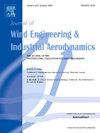大跨度三塔钢桁架斜拉桥气动弹性模型设计方法
IF 4.9
2区 工程技术
Q1 ENGINEERING, CIVIL
Journal of Wind Engineering and Industrial Aerodynamics
Pub Date : 2025-06-20
DOI:10.1016/j.jweia.2025.106152
引用次数: 0
摘要
传统的桥梁气动弹性模型设计方法没有严格考虑桥塔轴向刚度和扭转刚度的相似性要求,不适合模拟三塔斜拉桥。此外,钢桁架斜拉桥气动弹性模型的阻尼比通常难以控制。本文首次提出了大跨度三塔钢桁架梁斜拉桥的气动弹性模型设计方法。对于桥塔模型,通过推导单轴多点弹性约束(UMEC)模型的力学原理,实现了多轴刚度解耦。对于钢桁架梁模型,通过将形状系统与刚度系统分离,实现了低阻尼比的仿真。制作了几何比例为1/160的全桥气动弹性模型。通过信号的时程和相位来识别模态的近似振型、频率和阻尼比。模态试验结果和湍流流场中的抖振特性进一步验证了所提设计方法的可行性和可靠性。研究结果可为类似桥梁的气动弹性模型设计和风阻研究提供有价值的参考。本文章由计算机程序翻译,如有差异,请以英文原文为准。
A design method of aeroelastic model for long-span three-tower steel truss girder cable-stayed bridges
Traditional design methods of aeroelastic model for bridges do not strictly consider the similarity requirements of the axial and torsional stiffness of bridge towers, and are not suitable for simulating three-tower cable-stayed bridges. Moreover, the damping ratios of the aeroelastic model for steel truss cable-stayed bridges are usually difficult to control. In this paper, a design method of aeroelastic model for long-span three-tower steel truss girder cable-stayed bridge is proposed for the first time. For the bridge tower model, the multiaxial stiffness decoupling is realized by deducing the mechanical principle of the Uniaxial Multi-point Elastic Constraint (UMEC) model. For the steel truss girder model, the simulation of low damping ratio is realized by separating the shape system from the stiffness system. a full-bridge aeroelastic model with a geometric scale ratio of 1/160 was fabricated. The approximate mode shape, frequency and damping ratio of the mode are identified by the time history and phase of the signal. The modal test results and the buffeting characteristics in the turbulent flow field further verify the feasibility and reliability of the proposed design method. The research results can provide valuable reference for the aeroelastic model design and wind resistance research of similar bridges.
求助全文
通过发布文献求助,成功后即可免费获取论文全文。
去求助
来源期刊
CiteScore
8.90
自引率
22.90%
发文量
306
审稿时长
4.4 months
期刊介绍:
The objective of the journal is to provide a means for the publication and interchange of information, on an international basis, on all those aspects of wind engineering that are included in the activities of the International Association for Wind Engineering http://www.iawe.org/. These are: social and economic impact of wind effects; wind characteristics and structure, local wind environments, wind loads and structural response, diffusion, pollutant dispersion and matter transport, wind effects on building heat loss and ventilation, wind effects on transport systems, aerodynamic aspects of wind energy generation, and codification of wind effects.
Papers on these subjects describing full-scale measurements, wind-tunnel simulation studies, computational or theoretical methods are published, as well as papers dealing with the development of techniques and apparatus for wind engineering experiments.

 求助内容:
求助内容: 应助结果提醒方式:
应助结果提醒方式:


